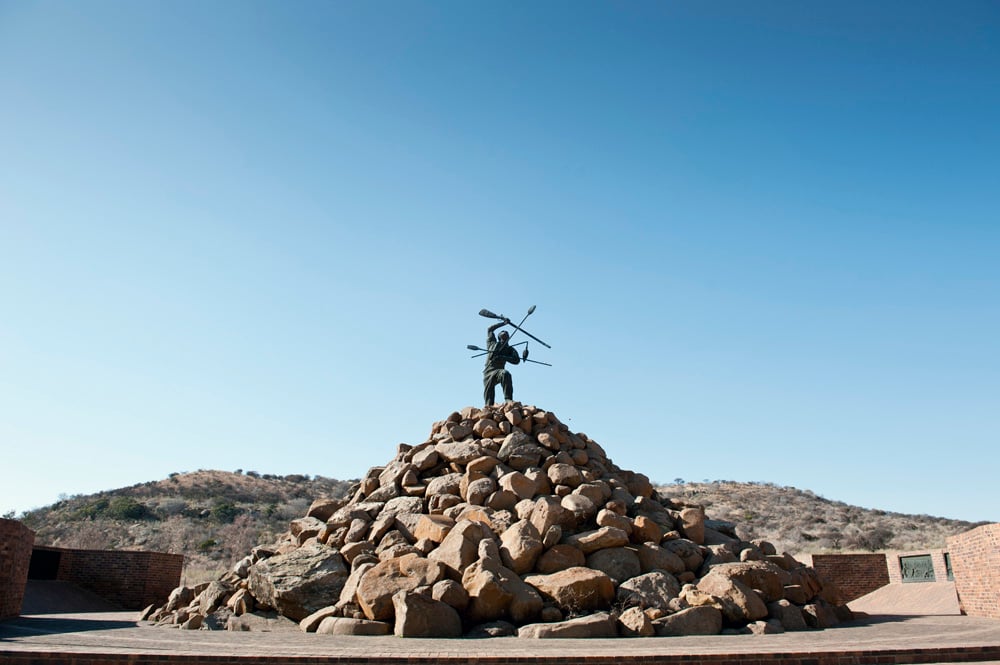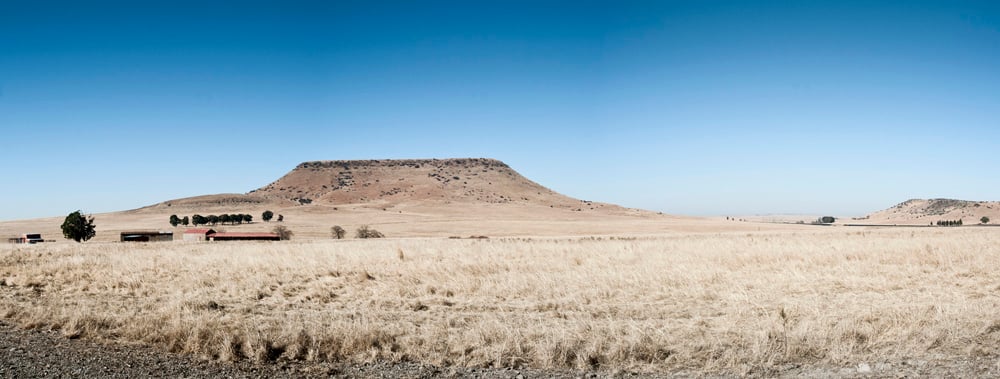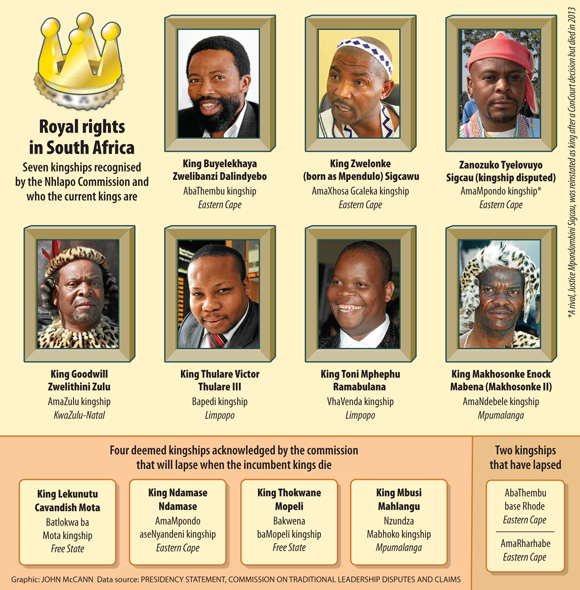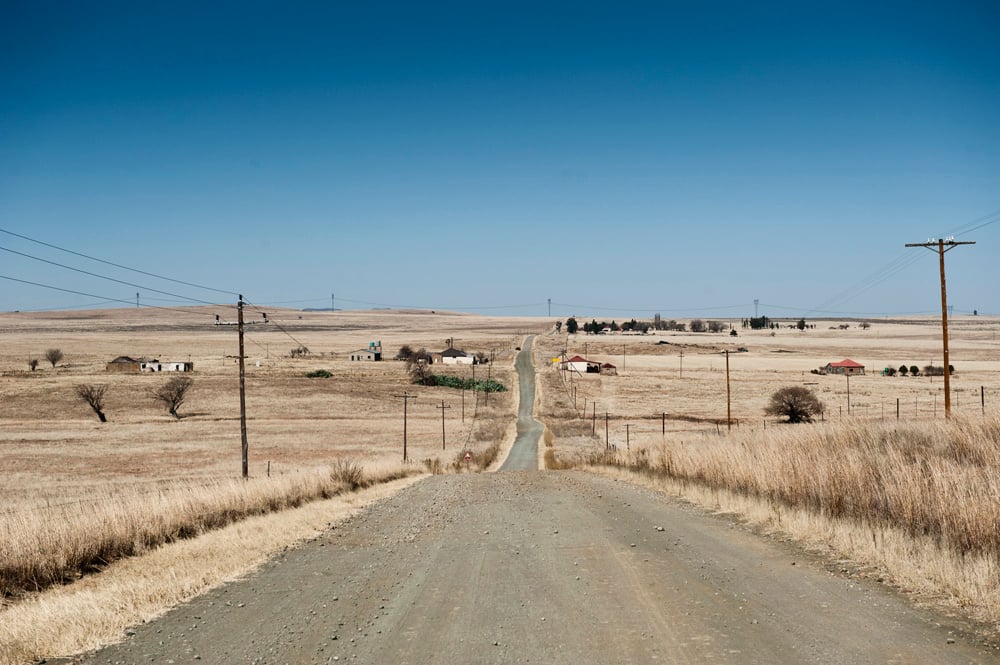The king leans slightly in towards me as I steady the flimsy Etios against the wind. “How can I ask for something that belongs to me?” he asks rhetorically, his eyes trained on me. I see him out of the corner of my eye. He is sitting squarely, as one does on a throne.
Ntsukunyane Motseki Matete (David Lebina Mofokeng), the self-styled “real king of the Basotho”, warns of an impending civil war if his “seven million people” – the Bafokeng ba-Mmutla O-Jeoa-Tala (also known as the Amavundla) – do not get what they want.
Matete says he wants land to build at least one million houses to the tune of R500-billion and restore the pride of a nation conquered in 1848 by Sir Harry Smith, the governor of the Cape, with his Orange River sovereignty proclamation. He has most of the Free State in his sights, as well as all of Lesotho. The money for the houses, he says, will be raised primarily from donations by his constituents.
Matete has a seriously spectacular claim. But for him, there are more pressing issues to overcome. The Nhlapo commission, set up by the Thabo Mbeki administration in 2004 to deal with the question of colonially endorsed traditional leaders, refused his request to have the mountain kingdom of Ntsoanatsatsi (near Vrede in the Free State) recognised.
“It was out of respect for the country’s laws that I approached the commission,” the heavy-set Matete says. “I don’t have to ask for recognition. The point was to get restoration for the kingship at Ntsoanatsatsi because it was conquered.
“In the dynasty of the Bafokeng ba-Mmutla O-Jeoa-Tala,” he says, “I am the 36th king.”
We are in the newspaper’s company car, a small, seemingly porous hatchback. Matete’s diction suggests he is speaking into an amphitheatre.
Lost faith
Matete says that in 2011, a year after the Nhlapo commission had ended and its successor, the Tolo commission, was established, he attended public hearings in Qwaqwa regarding the restoration of his throne. He lost faith in the commission when it was suggested that he contact Free State Premier Ace Magashule to take his claim forward.
“Issues of kingship are national. I saw no reason to see the premier,” Matete says. “My issue is national and international, as I need to address the issue of Lesotho.”
Matete, a portly man in a plaid baseball cap and a silver, heart-shaped aiguillette (royal ornamental cord) around his neck, carries a beaded staff with pale horsetail hair affixed to its end. A few weeks after our initial meeting, Matete agrees to a road trip to what he terms the founding kingdom of the Bafokeng ba-Mmutla O-Jeoa-Tala – “the original Sotho people”.

The prevailing historical narrative at conflict sites such as Vegkop barely mention the Bafokeng people. (Photos: Madelene Cronjé, M&G)
We are travelling on the N3 from Johannesburg in the direction of Warden. It’s a warm winter’s morning and Matete is in the mood for holding court. He argues that the throne of King Moshoeshoe, currently occupied by his descendant, King Letsie III, and the sovereignty of Lesotho are invalid as they are a result of colonial-era British protectionism.
He also says the “so-called” founder of the Sotho state was of Hlubi persuasion and therefore his successors have no claim over what is essentially a “Bafokeng crown”. As such, the land he is claiming encompasses all of Lesotho but also stretches wide and northwards in the shape of an upside-down triangle to include vast parts of the Free State and pieces of Mpumalanga, Gauteng and Phalaborwa in Limpopo.
Evidence
The basis for his case is a variety of materials: mostly anthropological books, photocopied notes from various sources and wherever corbelled houses are found, reaching from Phalaborwa to Matatiele.
Matete, owner of a taxi and tourism business, does not draw a salary from the state as he is an unrecognised traditional leader. He prides himself on his self-sufficiency.

‘King’ Matete says this Free State land belonged to his ancestors.
Our destination, Ntsoanatsatsi, is a flat-topped hill situated between the Free state farming towns of Frankfort and Vrede. For the journey Matete has brought along an assistant, who carries his reference books and holds down the pages for him as he reads into the platteland wind.
Currently part of a game farm owned by a white family, the Wesselses, it is apparently the founding seat of a nation he says was established by his ancestor Napo, “probably before” the late 10th century.
Coherent dates are not easy to ascertain from Matete. “In our research, people have been here for thousands of years,” he says. Matete is on a road bordering the northern side of the farm, several hundred metres from the foot of Ntsoanatsatsi.
‘Prehistoric times’
Ntsoanatsatsi, which means rising sun, currently bears the Afrikaans name of Tafelkop. “Napo was the first recorded among the people that settled here. Who was the leader before him? I don’t know and I won’t lie about that. If you look at the recordings of the missionaries, they say [the 10th century] was his time in this area. But we say that might be before because we are speaking about prehistoric times.”
Matete says that in some parts of Gauteng, these corbelled house-dotted mountains have been “erroneously” called Thaba tsa Batswana (the Batswana mountains).
Outside Ntsoanatsatsi, Matete is unable to locate the owners of the farm for a tour around the flat-topped hill. We drive about a 20km radius with Matete pointing out several hills of significance to his ancestry. To cement his theory, he reads an extract of a book by D Fred Ellenberg, titled A History of Basotho, Ancient and Modern. It is a passage about the Bafokeng ba-Mmutla O-Jeoa-Tala “in all probability” being “the first Bantu to cross the Vaal” southwards.

Zanozuko Sigcau’s kingship is disputed as it was overturned on a procedural basis but not on merits as the court found that “there was no need to deal with the merits of the legal dispute as to who should be king”.
Curiously, Matete is quick to discredit the very sources he quotes from if it will support a point he is making. As he reads the select extracts in the manner of a preacher, while pointing out various significant hills around the typically flat landscape, he often stops to highlight what he calls “distortions” – as he does with a line referring to his ancestor Napo as a Bakwena.
He dismisses the Mfecane inter-ethnic conflicts of the 19th century as an “alibi” for land-grabbing by white groups. “I’m in agreement with someone like [historian] Julian Cobbing, that the wars of displacement came from the Western Cape and moved upwards. From the north, it was the Portuguese pursuing the slave trade from Mozambique, down into the Zulu areas like Hluhluwe and even into Zimbabwe, looking for people to enslave.
“If Shaka was this mass murderer who was plundering land and killing people, why is it that that same land subsequently went under their [white people’s] control?”
Rhetorical questioning
With the Mfecane widely acknow-ledged as historical fact, one can only take Matete’s persistent line of questioning as rhetorical.
Although Matete does not say so directly, the quoting of Deuteronomy 17: 14 also suggests that he sees himself as divinely ordained to have subjects. The King James version reads thus: “When thou art come unto the land which the Lord thy God giveth thee,/ and shalt possess it,/ and shalt dwell therein,/ and shalt say,/ I will set a king over me,/ like as all the nations that are about me.”

Matete has most of the Free State in his sights, as well as all of Lesotho.
To this end, Matete has collated a trove of documents numbering well over 100 pages, detailing his plans, the genealogies of the Bafokeng tree as well as grievances he seeks reparations for. Some of these pages draw from the source material he has already read from, without citation.
A section of grievances lists at least 16 incidents of colonial disruptions to his lineage. Among them is the claim that the British Empire and the Paris Evangelical Mission Society – acting as allies of Moshoeshoe – poisoned and mysteriously killed a number of Bafokeng chiefs.
Having failed to find anything more than a long-distance sighting of stone ruins, Matete suggests we go to Vegkop, a museum about 50km west of Heilbron that is the site of a deadly confrontation between the trekboers and the amaNdebele in 1836.
Bafokeng territory
A monument and statue at the foot of the hill frames the conflict in the terms of Christian civilisation triumphing over a “total onslaught”, and the narrative inside the museum walls barely mentions the Bafokeng. The hike up the flat-topped hill is arduous. Throughout the climb, he never lets go of his staff, holding it close to him as he does his claim over the Free State and Lesotho. The apex reveals dilapidated corbelled houses for human shelter and wider ones resembling kraals.
Matete once again insists that this was where the Bafokeng lived and that the narrative about the Ndebele is probably a “distortion”.
It is on our journey back that I realise that, except for his dutiful assistant, I have not met any of Matete’s subjects to discuss weighty matters of “Amavundla” representation. He tells me he will organise a press conference for me to meet his council of chiefs and hear from the seven million-strong masses themselves, spread throughout the Free State and the fringes of KwaZulu-Natal, where the Bafokeng-Amavundla can be found.
As we near Johannesburg, Matete says he has already lodged his case for the restoration of Lesotho with the United Nations Human Rights Commission but in the meantime he will have to work hard to temper the agitation of his millions of followers.
Tefetso Mothibe, an eminent Sotho historian and professor based at the National University of Lesotho, says the protection of Lesotho by the British is a “complex” issue, and that Moshoeshoe had objective conditions for seeking out that protection. “If you are familiar with the Nhlapo commission’s findings, you would understand that they say Letsie III is the rightful king of the Basotho people here and in South Africa. I view those findings as legitimate.
“In terms of our history, there is nothing Hlubi about Moshoeshoe. These issues go back to the Mfecane, troubles that occurred in the Highveld that led to the dispersion of Hlubi people. They became part and parcel of the Sotho people in some instances. I have not heard of a claim by the Bafokeng. Of course the Bafokeng played a role in Lesotho, and Moshoeshoe himself married a Bafokeng woman.”
In November last year Matete received a letter from President Jacob Zuma informing him that the government could not rule on his kingship claim over Lesotho as it did not have the jurisdiction to do so.
Kings lay claim to most of the country
South Africa has 11 kings who are paid for by the state, courtesy of the taxpayer. But that number may well change. The status of some of these kings is being legally challenged by a number of parties unhappy with the findings of the Nhlapo Commission.
The Nhlapo Commission, which sat between 2004 and 2010, sought to clean up the institution of traditional leadership by resolving disputes but has since been legally challenged on most its findings.
This year, some of these kings, most notably the Zulu monarch King Goodwill Zwelithini, as well as others (some not recognised by the Nhlapo Commission as kings) have claimed vast swaths of land. And some are claiming the same land. The delineation of boundaries is murky, which is likely to cause further dispute.
The Ingonyama Trust, which holds close to three million hectares of land in trust in KwaZulu-Natal, is facilitating the Zulu king’s claim for land belonging to the kingdom in 1838.
At the same time, the amaHlubi, led by King Mthimkhulu III, are seeking restitution and financial rights for the same tracts of land.
The enormity and reach of some of these claims are such that most of South Africa is now up for grabs, including cities such as Durban, Cape Town and Tshwane. The impetus for these claims appears to be the reopening of the process by the recent signing into law of the Restitution of Land Rights Amendment Act, though the Act relates to claims after the 1913 cut-off date. The Natives Land Act of 1913 allocated just 7% of arable land to Africans.
A previous version of this article incorrectly identified historian Julian Cobbing as Gillian Kopley. This error has been corrected and we apologise for the error.